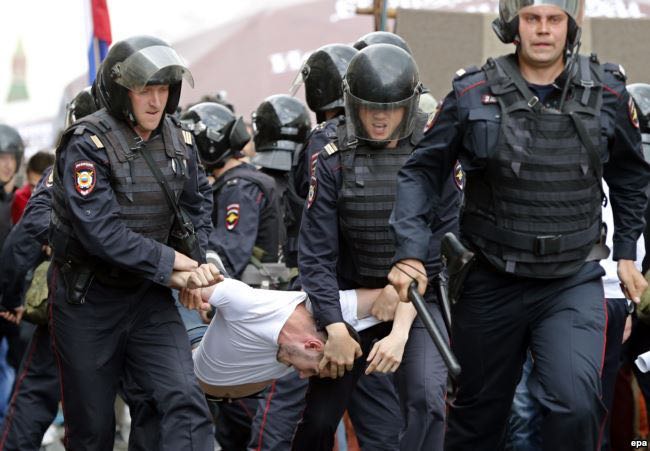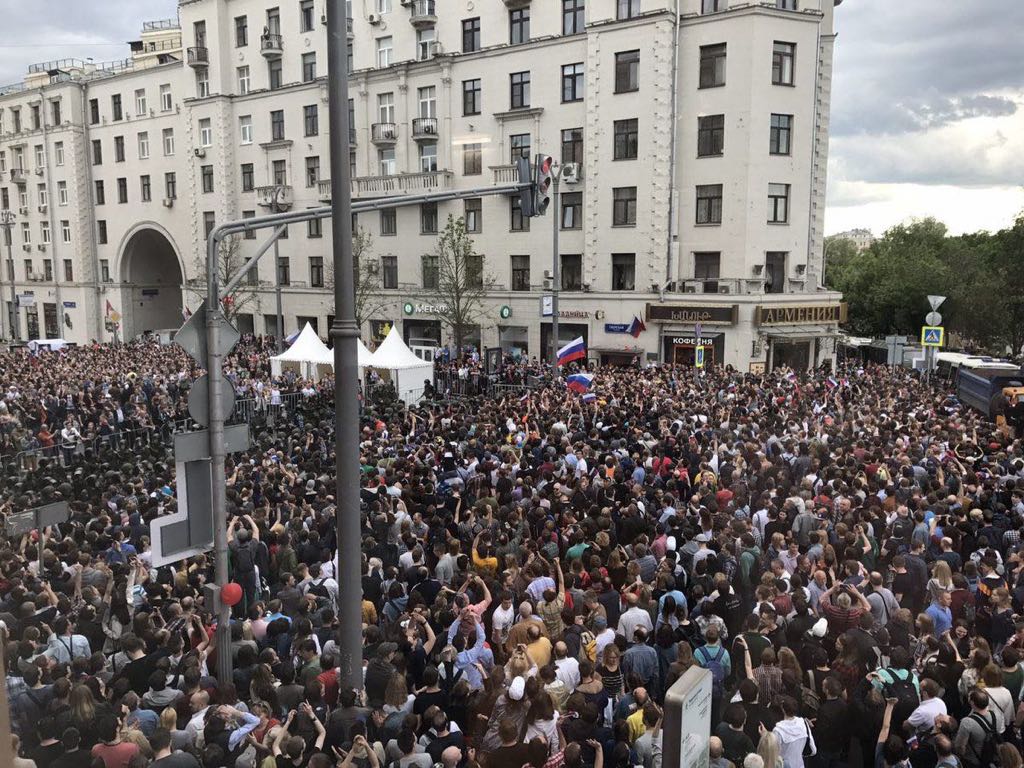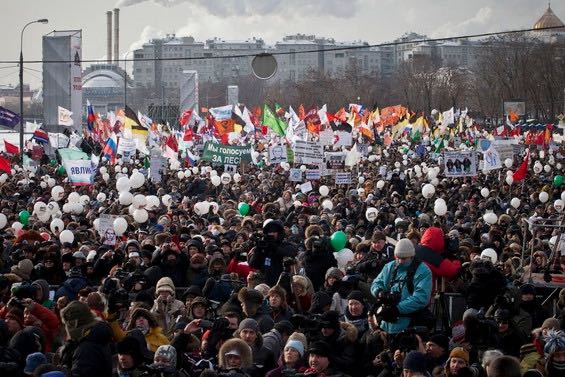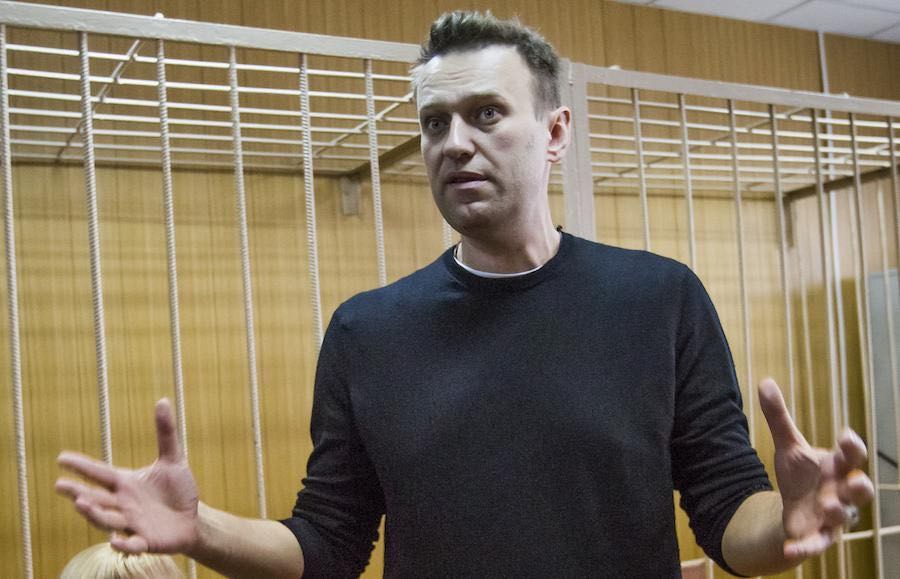On June 12 Alexei Navalny again succeeded in bringing people to the streets in Russia. But street protest is no political program and may end up as badly as the demonstrations of 2012, argues journalist Anna Arutunyan. If Navalny wants to play a role in politics, he has to challenge the Kremlin in a more serious way.
 Riot police arrest protester in Moscow on June 12
Riot police arrest protester in Moscow on June 12
For a second time this season, Russian opposition leader Alexei Navalny brought tens of thousands of people to the streets in an anti-corruption protest wave that is sweeping the country. The first protests on March 26 took place in 80 cities across Russia, showing for the first time an opposition movement with a network that reached far beyond Moscow and St. Petersburg. On June 12, with demonstrations in 160 cities, Navalny confirmed what observers were tentatively putting forth after March 26: his supporters are growing, his base reaches across the country, and the movement he sparked isn’t going anywhere.
Which is why one of the best things Navalny could do right now if he intends to play the long game and have a chance at political power is stop protesting, or, at the least, not make protesting his top priority.
Avoiding the 2012 trap
The mood on June 12 in Moscow came eerily close to the Bolotnaya riots of May 2012, and that doesn’t necessarily bode well if we consider the aftermath of the Bolotnaya movement itself. The violent demonstration on May 6, 2012 – the culmination of a months-long protest wave of 2011-2012 against alleged election fraud – sparked a massive political reaction in the Kremlin that is still felt to this day, and resulted in the arrests of dozens of young activists whose only crime was following the calls of opposition leaders. Three people are still serving jail terms. Sadly, the opposition itself came away with no more political leverage than it had to begin with, as the Kremlin cracked down on dissent.

On June 12, while Navalny had initially managed to negotiate an authorized rally with Moscow authorities to be held on Sakharov Prospekt, he changed the venue at the last minute, citing sudden refusals by Moscow authorities to allow sound equipment. This does not come as a surprise: the Kremlin is genuinely concerned about the threat Navalny poses, and while it has opted to keep him out of jail and allow him to hold demonstrations, it has also tried to make this as difficult as possible with threats, arrests, harassment of activists, and then the refusal to allow sound equipment.
In response, Navalny took a gamble on June 12 that ended only as a seeming success. He moved the venue to Moscow’s central street, Tverskaya, which was already blocked off for a Russia Day historic reenactment festival. His logic was that supporters would take a peaceful walk that would not be in violation of any law because the street was filled with crowds anyway. Authorities called the move a provocation, and in spirit, at least, they were right: calling thousands of politically-charged protesters to a street already filled with civilians, children, tents and food stands could prove to be a logistical nightmare at best. It also endangered civilians – families who may not have meant to attend Navalny’s protest were made vulnerable to indiscriminate attacks by riot police who would find it hard to distinguish a civilian from a protester.
As a result, the fact that at least 5.000 protesters showed up despite the threats of arrest spoke well to Navalny’s growing support base, but it jeopardized his popularity among average Russians who are still vulnerable to Kremlin propaganda about Navalny as a reckless revolutionary. By mixing his protest with civilians, he risked playing right into that propaganda line.
More importantly, the clashes with police suggest there is a danger that his followers are falling into the same intoxicating trap as before: dynamic street action, after all, the thrill and danger of dodging riot police is far more exciting and, most importantly, newsworthy than the mundane, relatively boring task of forging nationwide networks and fostering legal leverage.
It was that dynamism that propelled Monday’s protests to headlines worldwide: 1.700 arrested across the country, and 866 in Moscow alone, according to figures cited by OVD-Info, the ngo that monitors political arrests. Beying in the middle of the standoff, it is easy to get carried away by the romanticism.
I saw protesters idly – and dangerously – taunting steely-eyed riot police. When a helmeted officer swung his baton at a protester, the protester yelled, 'Hit me again!' When protesters were snatched at random and dragged off by police – often violently – demonstrators whistled, clapped and cheered. It was hard to understand the genesis of such sentiment until one considers the important PR premium such clashes hold for any political movement in Russia: world editors at foreign publications abroad are far more likely to cover events where there are mass arrests, and demonstrators themselves feel what they are doing is far more meaningful when the stakes are so high.
To gain recognition for Navalny’s movement, such PR campaigns may be a necessity, but given the political environment they are operating in, one must consider their expense: while most of the detainees will be released, we could see a handful of youngsters facing years in jail – just like in the aftermath of Bolotnaya. And Navalny does not yet have the political clout to get them out.
 Bolotnaya demonstrations in 2011/2012 were effectively suppressed by the Kremlin
Bolotnaya demonstrations in 2011/2012 were effectively suppressed by the Kremlin
In the heyday of the Bolotnaya movement [Bolotnaya is the square in the center of Moscow where the rallies took place], protests were held every few weeks, until they became monotonous. It’s clear that this time Navalny seems to have recognized that protests in Russia have only a limited premium: he waited over 2 months to have a repeat of the anti-corruption protests. In April, meanwhile, his campaign manager Vladimir Volkov told me they were focusing efforts on opening campaign offices across the country, not protesting.
Considering the cost and – as will be noted later, the limited efficacy of protest in Russia – this appears to be the wiser choice to keep the movement out of the monotonous trap it found itself in 2012, and, most importantly, to avoid outright clashes with the Kremlin – clashes that, at this point at least, the Kremlin will always win.
Agency, not victimhood
The bitter truth that may sound hard to digest is that street protests alone are unlikely to achieve any political leverage anytime soon in Russia. Even if we consider the last time that big crowds played any major role in policy – Perestroika – we should remember that it was largely a revolution from above, spearheaded by Mikhail Gorbachev. The success stories of Ukraine’s two Maidans – where popular uprisings managed to bring down the government not once, but twice, in 2004 and 2014 – come in a political environment that differs drastically from Russia’s. There, the groups that took to the streets against Viktor Yanukovich in 2004 and 2013-14 had a robust representation in parliament and in the halls of power. Russia, by contrast, boasts only a token opposition in parliament – only three or four members of the Just Russia party turned out for the Bolotnaya protest, and two were stripped of their mandates as a result.
Russia’s real, non-systemic opposition has zero leverage in the halls of power, and Putin’s Kremlin has gone to great lengths to keep it that way. What that means is that the most that a street protest could achieve in Russia is provoking the authorities towards real violence. Given the Kremlin’s growing fears of an 'Orange threat' (referring to Ukraine's Orange Revolution of 2004) this is becoming increasingly possible and the Kremlin is, ironically, becoming its own worst enemy: the growing powers it is giving its National Guard and the lethal force that it is granting its law enforcement are making clashes such as those that happened on Tverskaya more dangerous. Unfortunately, it is questionable that little other than bloodshed and repression could come from such a street standoff, given how little real leverage Navalny’s supporters currently hold in the branches of power.
Fortunately, Navalny’s movement itself has demonstrated that it is capable of gradually building that leverage, not through protest, but through outreach and legal work. What made the protests of March 26 different from those of the Bolotnaya movement were several things, but they all came down to one very important shift in Russian civil society: instead of making the protest about Putin and, therefore, about their own powerlessness, the opposition was, for the first time, taking the initiative into their own hands and staking on their own agency. Navalny’s protests weren’t so much in response to what authorities had done as they were a continuation of what his Anti-Corruption Foundation (FBK) had done itself: producing a high-quality, widely watched film detailing allegations of corruption against Prime Minister Dmitry Medvedev. Initially, it was this painstaking effort by FBK – rather than the thrill of protests alone – that managed to gain such a wide following.
 Alexei Navalny gets arrested at every demonstration. Last week he got 25 days of jail
Alexei Navalny gets arrested at every demonstration. Last week he got 25 days of jail
There is another, counter-intuitive advantage to this approach that Navalny would do well to continue to exploit: by making his efforts about corruption and not protesting Putin per se, Navalny would be courting a growing number of Russians who are exasperated by corruption but still support Putin. According to a recent poll by the Levada Center, 58 percent of respondents support anti-corruption protests – that in a country where Putin still enjoys an approval rating of well over 80 percent.
It is clear that Navalny has a next to zero chance of running, let alone winning in the 2018 presidential elections – no matter how many protests he holds. Instead, the successes he has achieved so far focused on outreach and legal work. His chances of a political future are pegged to that long-term effort. In the process, protests, if done right, could serve only as a secondary function, largely for the purposes of PR. Until Putin is gone – and it is not clear when, or how that could happen – Navalny’s best option is to continue his barrage of lawsuits, legal exposes, and the expansion of his network of campaigners and volunteers. All of that will come in handy down the line, when Navalny will be well-placed to compete with whomever else comes after Putin.
